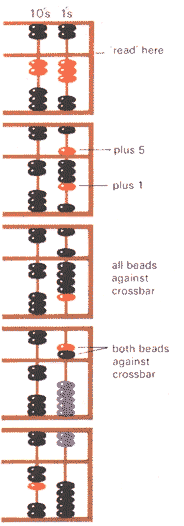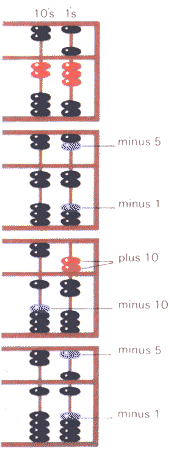
 |
How it works : Abacus |
ABACUS
![Beads in the upper section have five times the value of the lower ones [John Bishop]](HIW/ABACUS1.gif) The abacus is a hand-operated calculating machine in which numbers
are represented by beads strung on rods or wires set in a rectangular frame.
It is an extremely ancient device that has been in use for thousands of years
in various forms, and is still commonly used in China, Japan and parts of
the Middle East. The original version was probably a tray of sand divided
into strips by pieces of wood. Marks were made in the sand and wiped out
again as required.
The abacus is a hand-operated calculating machine in which numbers
are represented by beads strung on rods or wires set in a rectangular frame.
It is an extremely ancient device that has been in use for thousands of years
in various forms, and is still commonly used in China, Japan and parts of
the Middle East. The original version was probably a tray of sand divided
into strips by pieces of wood. Marks were made in the sand and wiped out
again as required.
The most usual form of abacus is the Chinese suan pan ('reckoning board'). This has up to 13 columns of beads, each divided in two by a crossbar running right across the frame. In each column there are two beads above the crossbar and five below it. Some other types have one and four beads respectively, but these are less easy to use.
In the far right-hand column, each lower bead represents one, and each upper bead five. This is the 'units' column. The one to the left of it is the 'tens' column, and here each lower bead represents 10 and each upper bead 50. The next column is the 'hundreds' column, where each lower bead represents 100 and each upper bead 500. This continues leftwards with thousands, tens of thousands and so on. A 13-column abacus can register numbers up to 9,999,999,999,999.
Numbers are 'entered' on the abacus by moving beads to touch the crossbar. To enter the number 23, for example, three lower beads are slid up the 'units' column to the bar, and two are slid up the 'tens' column.
To add 6 to this, one upper bead is slid down the 'units' column to the bar (thus adding 5) and one lower bead is slid up to the bar (adding another 1, making 6 in all). The abacus now reads 29.
If another 1 is added by sliding the last lower 'unit' bead up to the bar, there will be no more lower beads against the outside of the frame in this column. The lower part of the column is considered as 'full' and must be 'cancelled' immediately. This is done by sliding all five beads back to the outside of the frame and moving down one upper bead (worth ~) to take their place.
In this case, there is already one upper bead against the bar, so moving the other one down 'fills' the upper part of the units column too. This is also cancelled and one more lower bead moved up the next column, which is the 'tens' column, to add ten to the total. There are now no beads entered in the 'units' column, and three in the lower part of the 'tens' column. The abacus therefore reads 30, the correct answer.
Of course, a skilled operator would foresee, and so miss out, most of the intermediate steps in the procedure. With practice, it is possible to calculate at very high speed on an abacus at least as fast as an ordinary electric adding machine.
 |
Addition
Enter 23 (beads used to add are shown in red, beads used
to subtract in blue). |
Subtraction is performed by exactly the opposite process: for example, three is subtracted by moving three beads away from the crossbar in the lower part of the column.
The abacus is basically an adding and subtracting machine, and cannot be used to multiply by any one-stage process. This was a source of difficulty to the ancient Chinese - and the Romans, who used a comparable type of abacus. Neither the Roman nor the traditional Chinese numeral system allowed them to write numbers in columns, so they could not write down multiplication sums in the way used today.
For multiplication by a number up to, say, five, the number to be multiplied can just be added to itself the right number of times. But with larger numbers, this would take an inconvenient length of time, so another method must be used.
The two numbers (say 478 and 35) are written side by side, on a separate piece of paper, and under whichever of them is more convenient, half of that number is written. If this is not a whole number (35 ÷ 2 = 17½) the fraction is discounted (17). The half is now halved and halved again by the same method, right down to one: 35; 17; 8; 4; 2; 1. The other number is now doubled and re-doubled in a similar way, the same number of times as the first number was halved - this is a very quick series of additions on the abacus.
The sum now looks like this:
 |
Subtraction
Enter 28 |
478 x 35
956 17
1912 8
3824 4
7648 2
15296 1
The next stage is to strike out all the lines where the halved number is even (this would include the top line if it were even), leaving those where the halved number is odd:
478 x 35
956 17
15296 1
The doubled column is now added up on the abacus: 478+956+15296= 16730, which is the right answer.
Reproduced from HOW IT WORKS p1